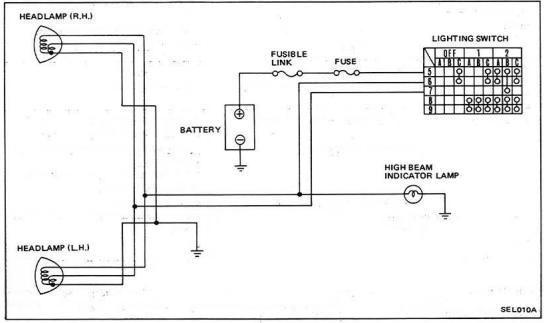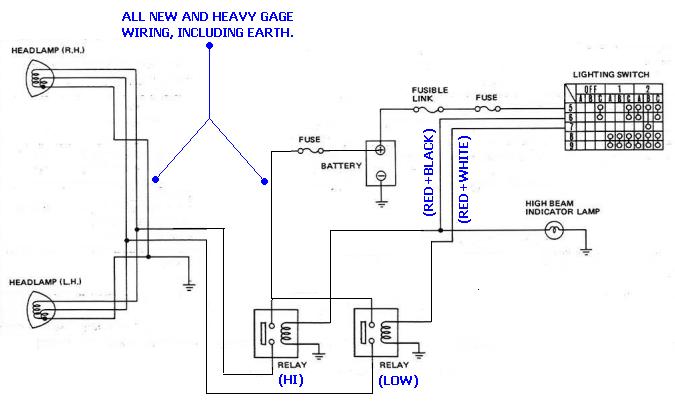Headlights - About, Upgrades and Repairs
-
Tagged with:
- Electrical
Table of Contents
Lamps
Round
Came in 12v for petrols, and 24v for early diesels (ie MQ model).
Rectangle
Only come in 12v for all vehicles in the MK models.
Wiring
The following wiring diagram has been taken from the 1980 service manual, Chapter 19 / EL.
Upgrade
As seen in the above diagram, the factory wiring is direct through the combination switch. This means all the power to the headlights has to run through the switch, which can cause them to become hot and in extreme cases melt. The factory wiring is also rather thin, which limits the current available to the headlights, meaning you arent getting the best possible light from your headlights.
The headlight circuit can be cheapily and easily upgraded, as show in the diagram below. The headlight wiring will run from the firewall down the RH side of the car. Simply cut the red with trace wires at a suitable location. Join these wires to the new relay terminals, then replace the rest of the wiring with new and heavy gage.
To perform this mod, you will require the following parts;
- Heavy duty wire of suitable amps (probably 20 for high beam). Using 3 different colors will keep your wiring logical, such as;
- Dark Yellow for the high beam circuit.
- Light Yellow for the low beam circuit. Can be lower gage (maybe 15A).
- Black for the earth. Needs to be equivalent gage to high-beam wiring.
- 2 relays
- Fuse holder. In-line and waterproof ones are good for this. Alternativley, relays can be purchased with fuses attached, but these must be mounted very close to the battery.
- Optional- You can buy new plugs for the headlights, to save re-using the old corroded ones.
- Various crimp joints and tape etc.
Faults and Repairs
Below are some common problems and causes. When fault-finding, check the causes in the order shown, as they are the most common and you should always check the easiest things first.
| Problem | Cause |
|---|---|
| Dim Lights | Low voltage. Corroded connections to headlight. Bad\Corroded earth. Faulty circuit in wiring or switch. |
| No Lights | Blown fuse. Broken switch. Bad earth. Broken wiring. Broken blobes. |
| One Light **(High OR Low)** Off or Flickering or Dim | Corroded power plug\wire at light. Partially broken globe. Faulty wiring on the lights individual wire (between the light and the 'fork'). |
| One Light **Always** Off or Flickering or Dim | Corroded earth at light plug. Faulty wiring on the lights individual wire (between the light and the 'fork'). |
Important note regarding blown fuses.
Fuses vary rarely fail on their own. A fuse is a safety device, it is designed to blow when the wiring circuit is taken beyond its capacity (ie if the wiring can only handle 12Amps max, a 10Amp fuse would normally be used). If your fuse has blown, it is because there is a problem elsewhere in the circuit. This would normally be a faulty component (ie headlight) or a short in the wiring. Never replace a fuse without checking the circuit first. Never replace a fuse with a higher rated fuse Doing so can cause the wiring to overheat and burn, along with your vehicle!
If your fuse and fuse holder have started to melt, this indicates your circuit is at max capacity. In this scenario, it is advised to upgrade your wiring as detailed above.

